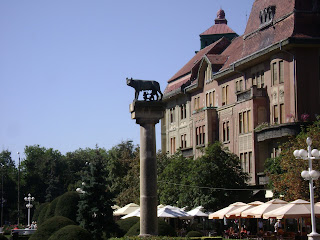
I have been very delinquent in posting to this blog. I started this one in September and now it is nearly one month later. I have also heard from many of you that the more photos that I can include, the better. I want to tell you about our first outing connected with our Hungarian class--our trip to the market. It was a fun time at the market that happened at the end of the students' first week here on August 28. We had all learned the Hungarian words for vegetables, fruit, 'how much does it cost?' and had learned how to count so that we could purchase items and make change.

This market is just a quick ride from the students' dorm on tram #18 on Fehervarti ut.

It is a very modern building and when you enter you can either go down a few steps to the lower level that has several sections or up an escalator to the main sales floor.

This picture shows the top two levels of the market. The top level sells ready made foods that you can have for breakfast, coffee or lunch. On the middle level you will find all sorts of fresh produce, poultry, meat and fish.

On the lower level there are two separate grocery stores and many meat, vegetable and pastry vendors and are open longer hours than the stalls on the second floor that close about 3pm or 4pm.
These shops are more permanent and seem to be thought of as lower quality or less fresh than those on the middle level. But still, if you arrive at the market after 4pm, you can still find a great variety of produce, eggs, cheese, etc.

You go up an escalator to the middle level which is full of all sorts of vendor stalls and shops--vegetables, slaw, flour, meal, nuts, honey, fruit, paprika, chicken, duck, goose, fish, etc. Everything you can think of is there.
The second floor is a feast for the eyes and the appetite. The center section has mostly fruits and vegetables. Also available are beans, nuts, honey, eggs, and paprika. You can see the meat shops along the side.

You can often find vegetables packaged ready for soup making--carrots, parsley root, onions, celery root, etc all in one package.
The parsley root is the long white vegetable in this package and is commonly used in soups and stews. It looks and tastes similar to what we would call a wild carrot in the US.

This is another vegetable that is commonly used in Hungarian cooking--the celery bulb. I think it's very interesting that one culture uses the bottom of a vegetable and another one uses the top!

Here are celery root and parsley root together.

These students are deciding what to buy. Their assignment was to speak only in Hungarian to make their purchase.

You can also buy flowers and paprika from many vendors. That's paprika in those large plastic bags. Hungarians use a great deal of paprika. Many times the red color in a dish is due to the paprika instead of tomatoes.

Along the side, near the meat cases, are shops that sell slaw and pickled items. Somethings on menus you will see "winter picklings" listed as a salad or appetiser choice.

Now to the meat! The pork is really the best. They have lots of it and it dominates most restaurant menus. It is beautiful and fairly inexpensive, as food goes, and comes in the same cuts as in the US.
The cuts of beef are more of a mystery and make you wonder exactly where this meet came from! Also the beef that I have purchased has been so tough that now I just use pork in any recipe where meat is needed.

While I love fish, the fish in Hungary is not all that attractive. The only way I have found that it really tastes good is if it is fried. And I rarely order it since fried fish here tastes just like fried fish anywhere. It's good, but there is so much else to enjoy that I won't be able to have back home.

This is carp. You can see how it is scored to allow it to be cooked with the bone left in it. Again, I haven't been too eager to try carp.

Here is Corwin's favorite food. He especially likes the way the chickens still have their feet. In addition, there are all sorts of extra parts available--liver, heart, gizzards, etc.

Then on the upper level (another escalator) is an area of shops selling ready made foods for lunch or snacks. Here you can buy soup, goulash, fried fish, desserts.
Our last assignment was to order (in Hungarian) and taste some typical Hungarian foods. These students are eating langos (pronounced langosh). Langos are a bit like elephant ears--big pieces of fried dough. They can be ordered with any number of toppings--cheese, ham or sweet toppings like strawberries.

The seating is at long tables with benches. Everyone sits together--wherever you can find a seat. Here are some more of us eating langos and palancinta. Palancinta are crepe-like ultra thin pancakes. They fill them with all varieties of fruit filling, jam, or turos (similar to ricotta cheese or cheesecake like filling) and roll them up for easy and delicious eating. Our Hungarian teacher, Ms. Kati Fugedi (in the black striped top), is expressing her approval of our choices and use of the Hungarian language.































